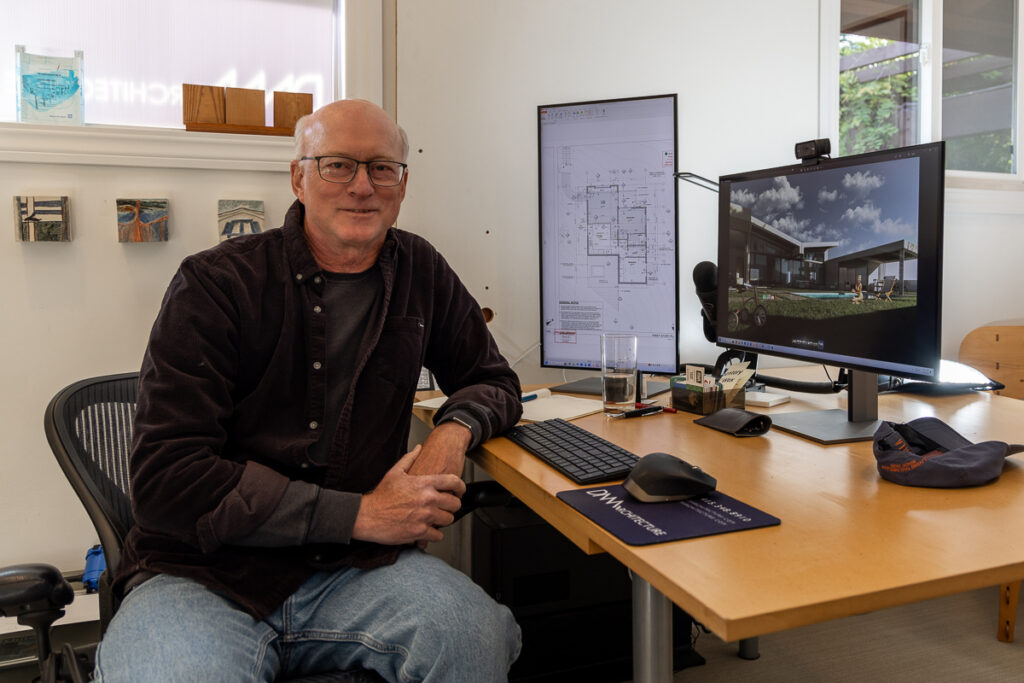
David Marlatt, AIA, working with architectural software
Several years ago, Dava Sobel wrote an excellent book called Longitude, that described the centuries long quest for a device to accurately measure longitude while at sea. Incredibly, prior to having such a device, called a marine chronometer and invented by John Harrison around 1761 (there were multiple iterations), sailors simply did not know where they were or where they were going. It is stunning to think now that all the great explorers and mariners before the late eighteenth century were fundamentally lost and moreover, they knew they were lost. It is even more stunning to think that their awareness of their own ignorance did not stop them from setting sail on ever more ambitious adventures, so great were the potential rewards for the shrewd and the lucky.
This story contains parallels with the way that architectural practice has navigated new technologies during the past few decades, finding itself tossed about in seas of changing expectations searching for relevance and direction. Starting somewhere in the 1980’s with 2D CADD software on mini and microcomputers, through the internet, worldwide web, 3D modeling and simulation, BIM, and, more recently, artificial intelligence, fast changing technology has often disoriented architectural practice and potentially threatened it both economically, but even existentially. There is a queasy feeling of being somewhat lost and tossed in all of this change, but the promise of great architecture is too strong.
In fact, however imperfectly, architects as a whole have found the opportunities in many of these new technologies to become more cost efficient, improve the quality of their documents, reduce errors, and especially broaden their scope of services.. For those firms that could afford the high cost and learning curve at the time, even early 2D CADD software delivered greater efficiency and improved accuracy. Later software that could cross reference multiply drawings other and data bases meant architects could play a role in facilities management. The development of 3D modeling tools improved efficiency and accuracy once again but broadened the architect’s potential role to provide services such as collision detection, time based simulation and computer rendering. Currently, Building Information Management, or BIM, encapsulates this idea of the architect as “keeper of the virtual building.” Far from posing an existential threat to the profession, the number of US architects per capita in the US has steadily increased year over year for decades according to NCARB.
Artificial Intelligence is the latest great wave of new technology sweeping over the profession (and all of society). As a tool to improve efficiency and quality, it promises, for example, real-time code compliance checking. Seen as an existential threat, however, it promises (threatens?) to generate design permutations based on key words and code knowledge at a hallucinating speed that is unsettling. But, as unsettling as this computing power may be, who edits and prioritizes the key words? Who selects among the plan permutations? Whose imagination will be triggered by the AI output data to discover entirely new design directions never considered? Who will communicate with the client, community, consultants and other constituents? Who will move the design from something derivative to something unique?
Comparing 21st century architects with 18th century mariners may seem like a stretch, but there is nothing new about navigating with uncertainty during major technological shifts. While technology can be grand, complex and overwhelming, it is always just a means to another end, a vessel to carry us from one century to another. For architects, the ultimate goal of the profession is not to practice in one manner or another, but to make better buildings. This means better practicing more efficiently and more effectively so that we, as architects, can play an even greater role in planning and building all that is around us.
The absorption of Artificial Intelligence into design practice will certainly impact staffing, job descriptions and responsibilities within firms, but it does not have to be a threat to practice any more than the many new tools that preceded it. Architects will find their place in this new world of AI as they have with every past technology wave because their inherent holistic three-dimensional thinking and problem-solving skills remain unique and ever more valuable.
